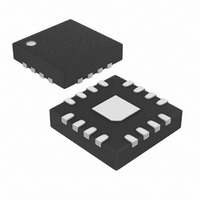MAX9723AETE+ Maxim Integrated Products, MAX9723AETE+ Datasheet - Page 10

MAX9723AETE+
Manufacturer Part Number
MAX9723AETE+
Description
IC AMP AUDIO .06W STER AB 16TQFN
Manufacturer
Maxim Integrated Products
Series
DirectDrive™r
Type
Class ABr
Datasheet
1.MAX9723DETE.pdf
(25 pages)
Specifications of MAX9723AETE+
Output Type
Headphones, 2-Channel (Stereo)
Max Output Power X Channels @ Load
60mW x 2 @ 16 Ohm
Voltage - Supply
1.8 V ~ 3.6 V
Features
Bass Boost, Depop, I²C, Mute, Short-Circuit and Thermal Protection, Shutdown, Volume Control
Mounting Type
Surface Mount
Package / Case
16-TQFN Exposed Pad
Product
General Purpose Audio Amplifiers
Output Power
60 mW
Thd Plus Noise
0.006 %
Supply Current
4 mA
Maximum Power Dissipation
1349 mW
Maximum Operating Temperature
+ 85 C
Mounting Style
SMD/SMT
Audio Load Resistance
16 Ohms
Minimum Operating Temperature
- 40 C
Amplifier Class
AB
No. Of Channels
2
Supply Voltage Range
1.8V To 3.6V
Load Impedance
16ohm
Operating Temperature Range
-40°C To +85°C
Amplifier Case Style
TQFN
Rohs Compliant
Yes
Lead Free Status / RoHS Status
Lead free / RoHS Compliant
the headphone. The MAX9723A and MAX9723B have a
maximum amplifier gain of 0dB while the MAX9723C
and MAX9723D have a maximum gain of +6dB.
Amplifier volume is digitally programmable to any one
of 32 levels.
Traditional single-supply headphone amplifiers have
their outputs biased at a nominal DC voltage, typically
half the supply, for maximum dynamic range. Large cou-
pling capacitors are needed to block this DC bias from
the headphone. Without these capacitors, a significant
amount of DC current flows to the headphone, resulting
in unnecessary power dissipation and possible damage
to both headphone and headphone amplifier.
Maxim’s DirectDrive architecture uses a charge pump to
create an internal negative supply voltage. This allows
the MAX9723 headphone amplifier outputs to be biased
at 0V, almost doubling the dynamic range while operat-
ing from a single supply. With no DC component, there is
no need for the large DC-blocking capacitors. Instead of
two large (typically 220µF) tantalum capacitors, the
MAX9723 charge pump requires only two small 1µF
ceramic capacitors, thereby conserving board space,
reducing cost, and improving the low-frequency
response of the headphone amplifier. See the Output
Power vs. Charge-Pump Capacitance and Load
Resistance graph in the Typical Operating Characteris-
tics for details of the possible capacitor sizes.
Stereo DirectDrive Headphone Amplifier
with BassMax, Volume Control, and I
Figure 1. Traditional Amplifier Output vs. MAX9723 DirectDrive
Output
10
______________________________________________________________________________________
CONVENTIONAL AMPLIFIER BIASING SCHEME
DirectDrive BIASING SCHEME
V
V
GND
+V
SGND
-V
DD
DD
DD
DD
/2
DirectDrive
In addition to the cost and size disadvantages, the DC-
blocking capacitors required by conventional head-
phone amplifiers limit low-frequency response and can
distort the audio signal.
Previous attempts at eliminating the output-coupling
capacitors involved biasing the headphone return
(sleeve) to the DC bias voltage of the headphone
amplifiers. This method raises some issues:
1) The sleeve is typically grounded to the chassis.
2) During an ESD strike, the amplifier’s ESD structure is
3) When using the headphone jack as a line out to
The MAX9723 features a low-noise charge pump. The
600kHz switching frequency is well beyond the audio
range, and does not interfere with the audio signals.
This enables the MAX9723 to achieve a 99dB SNR. The
switch drivers feature a controlled switching speed that
minimizes noise generated by turn-on and turn-off tran-
sients. Limiting the switching speed of the charge
pump minimizes di/dt noise caused by the parasitic
bond wire and trace inductance. Although not typically
required, additional high-frequency noise attenuation
can be achieved by increasing the size of C2 (see the
Functional Diagram/Typical Operating Circuit).
The MAX9723 features a 5µA, low-power shutdown
mode that reduces quiescent current consumption and
extends battery life. Shutdown is controlled by a hard-
ware or software interface. Driving SHDN low disables
the drive amplifiers, bias circuitry, charge pump, and
sets the headphone amplifier output impedance to
20kΩ. Similarly, the MAX9723 enters shutdown when bit
seven (B7) in the control register is reset. SHDN and B7
must be high to enable the MAX9723. The I
is active and the contents of the command register are
not affected when in shutdown. This allows the master
to write to the MAX9723 while in shutdown.
Using the midrail biasing approach, the sleeve must
be isolated from system ground, complicating prod-
uct design. The DirectDrive output biasing scheme
allows the sleeve to be grounded.
the only path to system ground. The amplifier must
be able to withstand the full ESD strike. The
MAX9723 headphone outputs can withstand an
±8kV ESD strike (HBM).
other equipment, the bias voltage on the sleeve may
conflict with the ground potential from other equip-
ment, resulting in possible damage to the amplifiers.
The DirectDrive outputs of the MAX9723 can be
directly coupled to other ground-biased equipment.
2
C
Charge Pump
Shutdown
2
C interface












